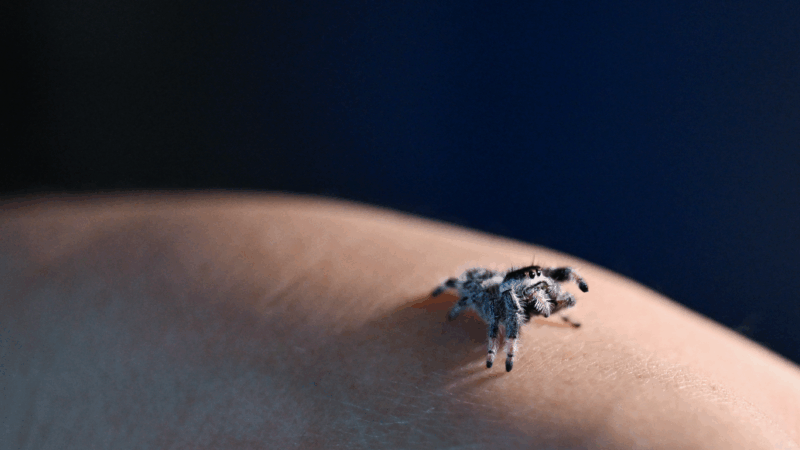Scared of spiders? Some former arachnophobes now are keeping jumping spiders as pets
For Emily Hess, it was a Phidippus regius named Gretel. Hayden Shea’s first was caught by her boyfriend’s dad. Sunday Costell ordered her first one off eBay.
Those spiders were the gateway bugs into the booming community of jumping spider pet owners. And thanks to social media videos of their head-tilting, leg waggling antics, these web-slingers are in high demand.
“I went from selling three to four a week to thousands a week,” said Costell, owner of Sundays Spiders outside Portland, Ore, who now has tens of thousands of “web puppies” in her shop.
These could-be pests have made the leap to hugely popular pets, particularly with women, sellers say, noting some women get interested as they try to overcome their fear of spiders, while others are simply enchanted by their unexpected cuteness. As a result, breeders are being flooded with requests online as videos rack up millions of views.

“There’s a lot of demand. I don’t even post mine anymore. I just wait. I just go based on the DMs on my Instagram,” said Shea, a breeder in St. Cloud, Fla.
There are thousands of different types of jumping spiders in the world, with 300 in the U.S. alone, according to the Bohart Museum of Entomology. They can jump up to a height of 40 times their body size, which is usually smaller than a penny.
Phidippus regius, commonly known as the regal jumping spider, is the largest type found in North America. They live in trees, which means they usually hang out at the top of their enclosures. And if you lose one in the house, you should look up.
The spiders come in a variety of colors, peachy oranges, inky blacks and white (which has been in high demand lately because they are rarer). And they shed their exoskeletons.
“They could change drastically over their molts,” said breeder Shea. “It’s really interesting. Like I’ve had some that are white and they go completely dark.”

From fear to favor
Paradoxically, many jumping spider owners were terrified of spiders to begin with. That was the case for Hess, who has built a following of 1.6 million on TikTok showing off her brood of “spoods” (as the internet has affectionately nicknamed the spiders).
“I live in Iowa. There’s spiders everywhere. And I was afraid of them my whole life,” said Hess. “And it was making things really inconvenient, because I couldn’t go into a room if I knew there was a spider in there.”
Hess, 40, started looking at spider pics to tame her fear. Then she learned that people kept them as pets.
“I got my first jumping spider and just fell in love with her and really bonded and it just kind of changed how I felt about them in general. And it worked. I’m not afraid of spiders anymore,” she said.

Arizona breeder Heather Mulligan had her first jumping spiders for two weeks before she built up the courage to handle them.
“I told my husband I was going to get a jumping spider. He said, ‘You’re not. You’re scared of spiders!'” said Mulligan, owner of Jumping Jewels AZ in Surprise, Ariz. “I was like, ‘Yeah, but these ones are so cute.’ So he went out of town for work and I got two.”
Now, Mulligan has a thousand of them that she breeds for sale – from pinprick-sized babies to big mamma spiders spinning egg sacks.
And she has a lot in common with her customers.
“Like 95% of my customers are female and they do not have the support of their partner,” she laughed.
Hess, who posts under the handle @mini_robomuppets, owns about a dozen jumping spiders, and each has a distinct personality.
“There are some that are super outgoing and some that are really high energy, some that are just really relaxed,” she said.
Once people overcome the fear, “they fall in love with their little personalities,” said Costell, the Pacific Northwest breeder.
And that change in perspective can lead to different attitudes toward creepy crawlies, the breeders said.
“Time and time again I get comments on social media from people that were arachnophobes and that killed every bug that they came across,” said Andrea Traid, owner of Little Spoods. “After learning about jumping spiders (even when not inclined to keeping them), it made them have a different perspective about spiders and bugs and instead of smooshing them, now they grab a cup and put them outside.”

The amazing spider
Jumping spiders are smarter than you think.
They don’t build capture webs, but pounce on their prey, said the University of Cincinnati’s Nathan Morehouse, whose lab studies jumping spiders. To hunt, they have to interact with their surroundings.
“These animals are working with a brain about the size of a poppy seed. So it’s tiny. And the complexity of their behavior is surprising given how small their brains are,” he said.
They can have stellar eyesight, can make plans and even have a sense of the difference between one, two and three things.
“They really do act like little cats in a certain way as they stalk things and play with things and move around,” said Morehouse.

But how does it work?
They’re popular, but far from a common household pet. Here are answers to some questions you might have about owning a jumping spider.
Are they hard to take care of? “They’re a step up from a pet rock,” said Mulligan. They require tiny enclosures – smaller than a shoe box – water and food (more on that below).
How much do they cost? A single spider can range from $30 up to around $100. There are many breeders online who can ship them. And PetSmart recently listed them for sale on its website, although the company did not respond to requests for comment.
What do they eat? This could be the dealbreaker for many people. Spiders need live prey like tiny mealworms, cockroaches and fruit flies. Emphasis on the word live. Because of the way they consume the bugs, they can’t be dried out. “They make their prey smoothie, basically, and then drink the inside. So you can’t feed them anything like dried worms,” said Mulligan.
Will they get lost? Breeders say they’re about as likely to get lost as a hamster, maybe even less so. If you’re handling them, they lay down anchor webs to your hands, so even if they leap away, they’re still tethered.
Do they bite? Yes, but not unless provoked. The spiders tend to bite people who stick their hands inside their enclosure, spooking the “spoods,” according to breeders. “I’ve handled hundreds and hundreds of them at this point. I’ve never been bitten once,” said Traid. And if you are bitten, it feels about the same as a bee sting.
How long do they live? About one to two years, although some breeders say they have spiders that have made it to their third birthday.
Can I pet them? Probably best not to, you might squish them. But if you’re lucky, you can get a boop.

Jeffrey R. Holland, next in line to lead Church of Jesus Christ of Latter-day Saints, dies at 85
Jeffrey R. Holland led the Quorum of the Twelve Apostles, a key governing body. He was next in line to become the church's president.
Winter storm brings heavy snow and ice to busy holiday travel weekend
A powerful winter storm is impacting parts of the U.S. with major snowfall, ice, and below zero wind chills. The conditions are disrupting holiday travel and could last through next week.
Disability rights advocate Bob Kafka dead at 79
Bob Kafka was an organizer with ADAPT (American Disabled for Attendant Programs Today), a group which advocates for policy change to support people with disabilities.
‘It’s behind you!’ How Britain goes wild for pantomimes during the holidays
Pantomimes are plays based on a well-known story — often a fairy tale — which are given a bawdy twist. The audience is expected to join in throughout, shouting as loudly as they can.
Kennedy Center vows to sue musician who canceled performance over Trump name change
The Kennedy Center is planning legal action after jazz musician Chuck Redd canceled an annual holiday concert. Redd pulled out after President Trump's name appeared on the building.
Our top global photo stories from 2025: Fearless women, solo polar bear, healing soups
These stunning photos include a polar bear in a Chinese zoo, a teen in Zambia facing an uncertain future, Mongolian kids watching TV in a tent, a chef prepping a bowl of good-for-you soup.







